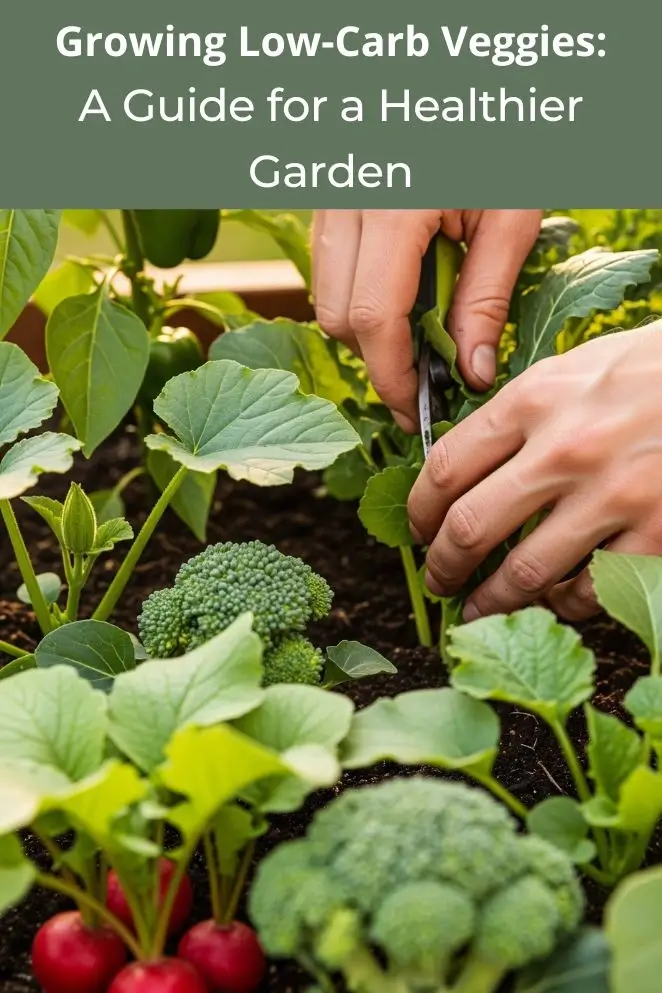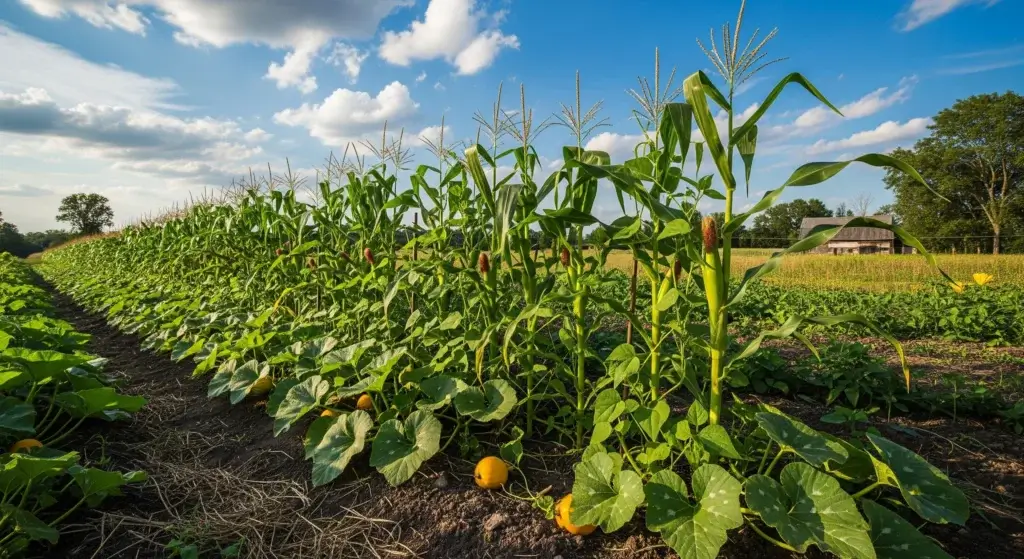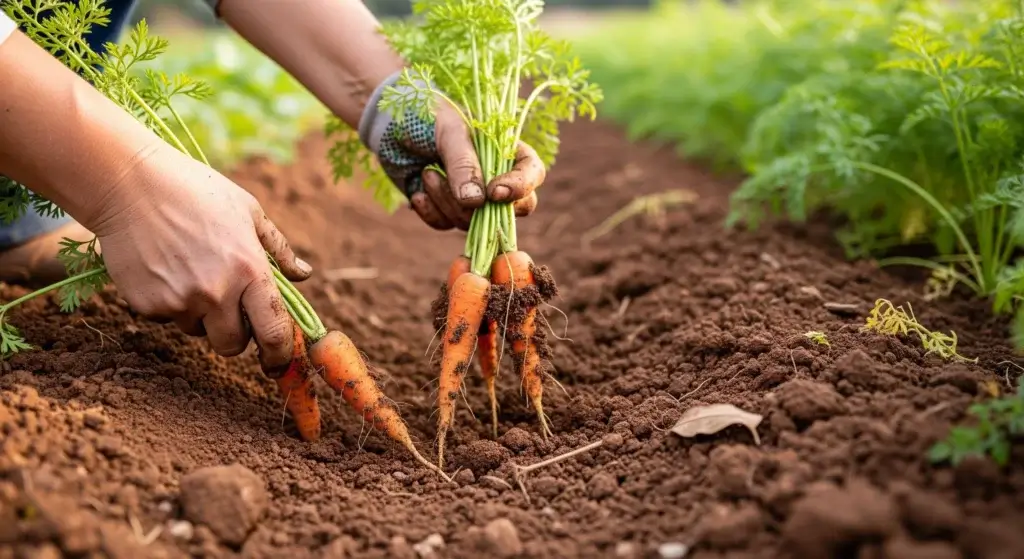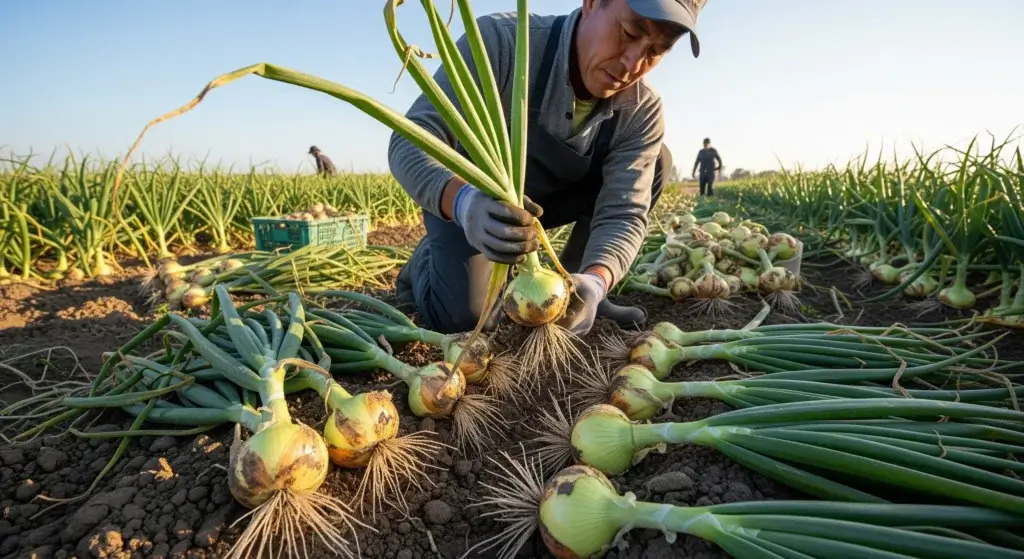
The intersection of health-conscious eating and sustainable gardening is kind of a big deal right now.
With so many people cutting carbs—whether it’s keto, managing blood sugar, or just trying to eat lighter—growing your own low-carb veggies makes total sense.
Low-carb gardening isn’t about missing out, it’s about loading up on nutrient-packed foods that are cheap, tasty, and good for you.
Understanding Low-Carb Vegetables: The Science Behind the Choices
The Above-Ground Rule
Here’s the cheat code: veggies that grow above ground are usually low-carb.
That means you can load up on them without stressing.
Most of these guys clock in at just 0–5 grams of net carbs per serving, which makes them perfect for low-carb eating.
Net Carbs vs. Total Carbs
This part trips people up. Total carbs count everything, but net carbs are what actually matter for blood sugar.
You get net carbs by subtracting fiber from total carbs (fiber doesn’t spike blood sugar, so it doesn’t “count”).
Lots of low-carb veggies are fiber bombs, so their net carbs are way lower than you’d think just looking at the label.
The Carbohydrate Spectrum
Most low-carb diets keep you under 130 grams of carbs a day, and some hardcore ones like keto drop as low as 20.
Wherever you land, you’ve got options. The vegetables in this guide are flexible enough to fit into any low-carb game plan.
Top 15 Low-Carb Vegetables to Grow in Your Garden
Leafy Greens
1. Spinach (0.4g net carbs per cup raw)
Spinach is basically the superhero of veggies—low in carbs, high in nutrients, and ridiculously versatile.
Growing Tips:
- Plant in early spring or fall—it loves the cool vibes.
- Thrives in partial shade (perfect if your garden’s not sun-soaked).
- Harvest the outer leaves first; the plant keeps pumping out more.
- Plant new seeds every 2–3 weeks for a never-ending spinach buffet.
2. Kale (1g net carbs per cup chopped)
Kale’s like that one friend who survives any situation—it laughs at frost, packs antioxidants, and makes smoothies, chips, and salads better.
Growing Tips:
- Cold-hardy, handles light frosts like a champ.
- Pick off yellowing bottom leaves to keep it fresh.
- Varieties like Red Russian or Winterbor stretch your season longer.
3. Lettuce Varieties (0.5–1g net carbs per cup)
Lettuce is the easygoing cousin of spinach and kale. Crisp, fresh, and the base for basically any salad.
Even picky eaters can vibe with lettuce.
Growing Tips:
- Pick heat-resistant types if summers in your area are brutal.
- Plant every 10–14 days for a steady supply.
- Harvest as baby greens—you’ll feel like a pro chef pulling fancy salads.
Cruciferous Champions
4. Cauliflower (2g net carbs per cup)
Cauliflower is the ultimate low-carb chameleon. Pizza crust? Rice? Mashed potatoes? Cauli can fake it all.
Growing Tips:
- Loves cool weather and steady moisture.
- Tie the leaves over the head to keep it white (that’s called blanching).
- Start with seedlings instead of seeds—it’s easier to get those nice big heads.
5. Broccoli (3g net carbs per cup)
This one’s the nutritional powerhouse—vitamins, antioxidants, and that crunch when roasted? Chef’s kiss.
Bonus: after you harvest the main head, the plant keeps spitting out side shoots.
Growing Tips:
- Plant in early spring or late summer.
- Snip the main head when it’s tight and green.
- Don’t pull the plant—the side shoots will keep rewarding you.
6. Cabbage (2g net carbs per cup)
The underdog of the garden. Cheap, reliable, and great for slaws or stir-fries.
Green cabbage is lower carb than purple, but honestly, purple makes your plate pop.
Growing Tips:
- Start with transplants for better odds.
- Keep the soil evenly watered to avoid heads splitting open.
- Match varieties to your growing season length.
Mediterranean Favorites
8. Zucchini (1g net carbs per cup sliced)
Zucchini is that plant that just won’t quit.
One summer, I had so much zucchini I was sneaking it into muffins, pasta, and even brownies. Spoiler: it worked.
Growing Tips:
- Wait until soil hits 60°F before planting.
- Pick fruits young and often—otherwise, you’ll get a baseball bat-sized zucchini.
- One plant = more zucchini than you think you can handle.
9. Bell Peppers (4g net carbs per cup)
Crunchy, colorful, and packed with vitamin C.
I still remember biting into a homegrown red pepper—way sweeter than anything from the store.
Growing Tips:
- Start with transplants, not seeds, unless you’ve got a long season.
- Needs warm soil and steady watering.
- Use stakes or cages—the heavy fruits can weigh plants down.
10. Cucumbers (2g net carbs per cup sliced)
Cucumbers are summer in veggie form—crisp, refreshing, and basically a salad MVP.
Pro tip: grow them vertically, and you’ll free up garden space.
Growing Tips:
- Loves warm soil with good drainage.
- Trellis or support vining types—they’ll climb like pros.
- Harvest often or they’ll turn into giant, bitter cukes.
Protein-Rich Options
10. Asparagus (2g net carbs per cup)
This one’s an investment—it takes a couple years to really get going, but once it does, it’ll keep producing for decades.
Growing Tips:
- Plant crowns (not seeds) in fertile, well-drained soil.
- Skip harvesting the first year; let the plants bulk up.
- Snip spears at 6–8 inches tall for best flavor.
11. Green Beans (4g net carbs per cup)
A bit higher in carbs, but still totally fine. Snap them fresh off the vine, and they taste sweeter than candy.
Growing Tips:
- Bush beans are easier for beginners.
- Plant after the last frost—beans love warmth.
- Pick pods young and tender for max flavor.
Unique Additions
12. Mushrooms (1g net carbs per cup)
Not technically a veggie, but mushrooms are low-carb legends.
Growing oyster mushrooms in buckets at home feels like magic—you just mist them, and boom, food.
Growing Tips:
- Oyster mushrooms grow well on logs or containers.
- Shiitakes thrive on hardwood logs.
- Starter kits are the easiest way to dip your toes in.
13. Radishes (1g net carbs per cup sliced)
The speed demons of the garden—ready in about 30 days.
Growing Tips:
- Direct seed every 2 weeks for a steady supply.
- Pick them young—they get woody if left too long.
- Experiment with funky varieties like watermelon or black radishes.
14. Arugula (0.8g net carbs per cup)
Peppery, punchy, and a little fancy. Arugula is the stuff that makes salads feel gourmet. And it grows crazy fast.
Growing Tips:
- Loves cool weather, sprouts in no time.
- Use the “cut-and-come-again” method to keep it going.
- It self-seeds like a wild child—once you plant it, it tends to come back.
15. Swiss Chard (1g net carbs per cup)
The flashy one—bright stems, dark leaves, and it actually tastes good. It’s like spinach’s tougher, hotter cousin.
Growing Tips:
- Handles heat better than spinach.
- Harvest outer leaves often, and it keeps producing.
- Don’t toss the stems—they’re crunchy and colorful in stir-fries.
Garden Planning for Maximum Low-Carb Production
Seasonal Succession Planting
Want veggies all year instead of a random glut you can’t finish? That’s where succession planting comes in—it’s basically “crop scheduling” so your garden never ghosts you.
Spring Focus (March–May)
Start with the cool kids—spinach, kale, and lettuce. They love chilly mornings.
Plant asparagus crowns now too—it’s like a long-term investment, but trust me, it pays off.
Also get your broccoli, cauliflower, and cabbage rolling before the heat shows up.
Summer Production (June–August)
When the sun cranks up, switch gears.
Zucchini, peppers, and cucumbers are summer all-stars.
Keep leafy greens alive by giving them some shade (think of it as a plant umbrella).
Keep tossing lettuce and arugula seeds every two weeks—you’ll never run out of salad.
Fall Harvest (September–November)
Now it’s back to sweater-weather crops: kale, broccoli, cauliflower.
Summer plants will still push out a bit until frost takes them down.
And here’s a pro move: plant garlic now, and you’ll thank yourself next summer when it’s ready.
Space-Efficient Design
Not working with a big backyard? No problem—small spaces can still crank out a ton if you play it smart.
Vertical Growing
Trellises are your besties—cucumbers and peas love climbing.
Stack containers like Lego towers, or try one of those vertical gardens where greens grow like a plant skyscraper.
Companion Planting
Here’s where you play matchmaker. Radishes grow fast, so stick them in with slowpokes like broccoli.
Lettuce makes great living mulch around taller plants—it shades the soil and looks fancy.
And don’t forget herbs: basil, mint, or rosemary keep pests away and make you look like a gourmet gardener.
Advanced Growing Techniques for Low-Carb Success
Container Gardening Solutions
Don’t have a giant backyard? No stress—container gardening is like gardening in “plant apartments,” and it totally works.
Perfect for beginners or anyone stuck with just a balcony.
Essential Container Requirements
Go for at least 6 inches deep for leafy greens (spinach, lettuce, etc.) and 12 inches if you’re growing root veggies or peppers.
Always make sure there are drainage holes—plants hate soggy feet.
And skip digging up dirt from your yard. Use real potting mix; it’s lighter, drains better, and doesn’t come with mystery bugs.
Best Container Varieties
Cherry tomatoes (look for low-sugar types), compact peppers, bush beans, peas, and literally every leafy green or herb.
My basil in a small pot once grew so big it looked like a mini tree—proof it works.
Soil Optimization
Think of soil as the Wi-Fi for your plants—if it sucks, nothing thrives.
Testing and Amendments
Check your soil pH—most veggies love 6.0–7.0 (basically “not too sour, not too sweet”).
Add compost every year to keep it fluffy and nutrient-rich.
If drainage is trash, root rot will take over, so consider raised beds if you want more control.
Organic Matter Integration
Turn kitchen scraps into gold—compost banana peels, eggshells, veggie leftovers (but don’t dump carb-heavy stuff like bread).
Aged manure is like protein powder for your soil.
Mulch keeps water locked in and weeds out. And if your garden goes on break in winter, toss in cover crops so the soil doesn’t just sit there bored.
Pest Management Strategies
Bugs happen, but you don’t have to go nuclear with chemicals. There are smarter hacks.
Integrated Pest Management (IPM)
Invite the good guys—ladybugs, bees, lacewings—by planting a variety of stuff.
Use row covers like tiny bug shields. Plant “trap crops” (like sacrificial decoys) to lure pests away from your main harvest. Rotate crops so pests don’t get too comfy.
Natural Deterrents
Marigolds and nasturtiums aren’t just pretty; they keep pests away.
Sprinkle diatomaceous earth to wreck crawling bugs.
Beneficial nematodes (tiny wormy heroes) fight soil pests underground.
And don’t forget—birds, frogs, and good bugs are basically your garden security team.
Common Challenges and Solutions
Climate Considerations
Your garden isn’t just about the plants—it’s also about the weather mood swings.
You gotta work with the climate, not against it.
Hot Climate Adaptations
Pick heat-tolerant varieties (trust me, lettuce will straight-up melt in July if you don’t).
Give cool-season crops some afternoon shade so they don’t crisp up.
A drip irrigation setup? Total lifesaver—it’s like an IV for your plants. And reflective mulch keeps the soil from feeling like a frying pan.
Cold Climate Strategies
If you’re dealing with frosty mornings, think of row covers and cold frames as plant jackets.
Go for cold-hardy crops (kale will laugh at snow).
Start seeds indoors early so they’re ready when it warms up.
And if you can swing it, a greenhouse or high tunnel is like giving your plants their own VIP lounge.
Beginner Mistakes to Avoid
Every gardener makes these at least once—I definitely planted tomatoes way too early one year, and they just sat there sulking like sad green sticks. Learn from my pain.
Timing Errors
Don’t plant warm-weather crops before the soil’s actually warm—tomatoes and peppers hate cold feet.
Keep succession planting in mind if you want more than one harvest.
Pay attention to the “days to maturity” on seed packets (it’s not just fine print). And frost dates? Ignore them, and you’ll be replanting.
Care and Maintenance Issues
Watering like a maniac one week and ghosting your plants the next will just stress them out.
Don’t overcrowd—plants need breathing room too. Feed your soil, because if the dirt’s weak, your plants will be too.
And if you see pests? Don’t wait until they’ve thrown a full-blown rave on your broccoli leaves—handle it early.
Conclusion: Growing Your Way to Better Health
Starting a low-carb garden isn’t just about food—it’s about taking control of your health and eating stuff that actually fuels you.
You’re basically swapping grocery store veggies (that sat on a truck for days) for fresh, nutrient-packed food you grew with your own hands.
Some crops, like radishes and lettuce, give you that instant gratification vibe—ready in weeks.
Others, like asparagus, are the long game—you wait a year or two, but then they keep giving for decades. That’s the beauty of it: every plant’s got its own personality.



